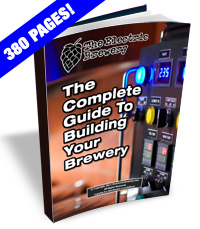Wort Chiller
After the wort has been boiled it needs to be chilled to a yeast-friendly temperature.
We use a counterflow chiller (CFC) to perform this wort chilling in our brewery. A CFC is a heat exchanger built as a coil within a coil where two liquids (hot wort and cold water) flow in opposite directions resulting in cooled wort and heated water.
 The outer tube in our chiller is made from 12 feet of 7/8" copper through which the cold tap water flows. The hot wort passes through the inner tube made of 5/8" convoluted (twisted) copper which continually turbulates the wort as it flows to maximize heat exchange. This results in a heat transfer that is so efficient that the exiting wort is never more than a degree or two above the temperature of the cold water, regardless of the speed at which the wort is pumped. Because of this convoluted or twisted inner tube, our CFC is more accurately called a convoluted counterflow chiller.
The outer tube in our chiller is made from 12 feet of 7/8" copper through which the cold tap water flows. The hot wort passes through the inner tube made of 5/8" convoluted (twisted) copper which continually turbulates the wort as it flows to maximize heat exchange. This results in a heat transfer that is so efficient that the exiting wort is never more than a degree or two above the temperature of the cold water, regardless of the speed at which the wort is pumped. Because of this convoluted or twisted inner tube, our CFC is more accurately called a convoluted counterflow chiller.
 Other methods of chilling wort exist, including immersion chillers and plate chillers. An immersion chiller is a coil of metal (usually copper) through which cold water flows. The coil is immersed completely in the hot wort and the entire volume of wort is chilled at once. A plate chiller is simply a more compact version of a counterflow chiller where plates are used instead of coils. These different wort chillers have different advantages/disadvantages. Which you choose to use depends on many factors.
Other methods of chilling wort exist, including immersion chillers and plate chillers. An immersion chiller is a coil of metal (usually copper) through which cold water flows. The coil is immersed completely in the hot wort and the entire volume of wort is chilled at once. A plate chiller is simply a more compact version of a counterflow chiller where plates are used instead of coils. These different wort chillers have different advantages/disadvantages. Which you choose to use depends on many factors.
We chose not to use an immersion chiller due to the following disadvantages:
- Inability to use a hop back: A hop back (such as the Blichmann HopRocket) adds an extra punch of hop flavour and aroma that can't normally be achieved in the brew kettle alone. It is a small container that holds hops through which hot wort is passed immediately before it is cooled by the chiller, locking in the hop character. While mostly only used in certain beer styles (most notably American Pale Ales and IPAs) we want to keep our options open.
- Wort is not chilled as rapidly: Because the entire wort volume is chilled at once it chills more slowly. If chilled slowly the wort spends more time in the temperature zone where it is more susceptible to infection. Slow cooling can also lead to excessive dimethyl sulfides (DMS) causing a 'cooked corn' taste and aroma in the beer. Cold break may also not come out of solution which can result in a hazy beer (called 'chill haze') once it is refrigerated for serving. With a counterflow chiller, small portions of wort are chilled instantaneously from boiling to yeast pitching temperature as it passes through the chiller.
- Less efficient, higher water usage: It takes longer to chill the same volume of wort from start to end with most immersion chillers. Because of this, more water is used.
Blichmann makes a popular plate chiller called the Therminator, but after much research we chose not to use it (or any other plate chiller for that matter) as they are more work to clean due to the tiny passages and the fact that they cannot be disassembled. Brewers are recommended to backflush their plate chillers and some even recommend cooking them in the oven periodically to keep them clean/sanitized. While a plate chiller is more efficient and uses less water, we feel a convoluted counterflow chiller such as ours offers the best compromise: Fast chilling and a simplified clean-in-place (CIP) solution.
Counterflow chiller installed on our brew stand:
Close-up:
The counterflow chiller comes with either 1/2" NPT female or bare 5/8" diameter copper pipe for the wort in/out lines, and standard male/female garden hose connections for the cooling water. We will be attaching male quick disconnects for wort transfer, reinforced vinyl hoses for water transfer, and a thermometer to monitor final wort temperature. The whole assembly will then be mounted to the brew stand.






